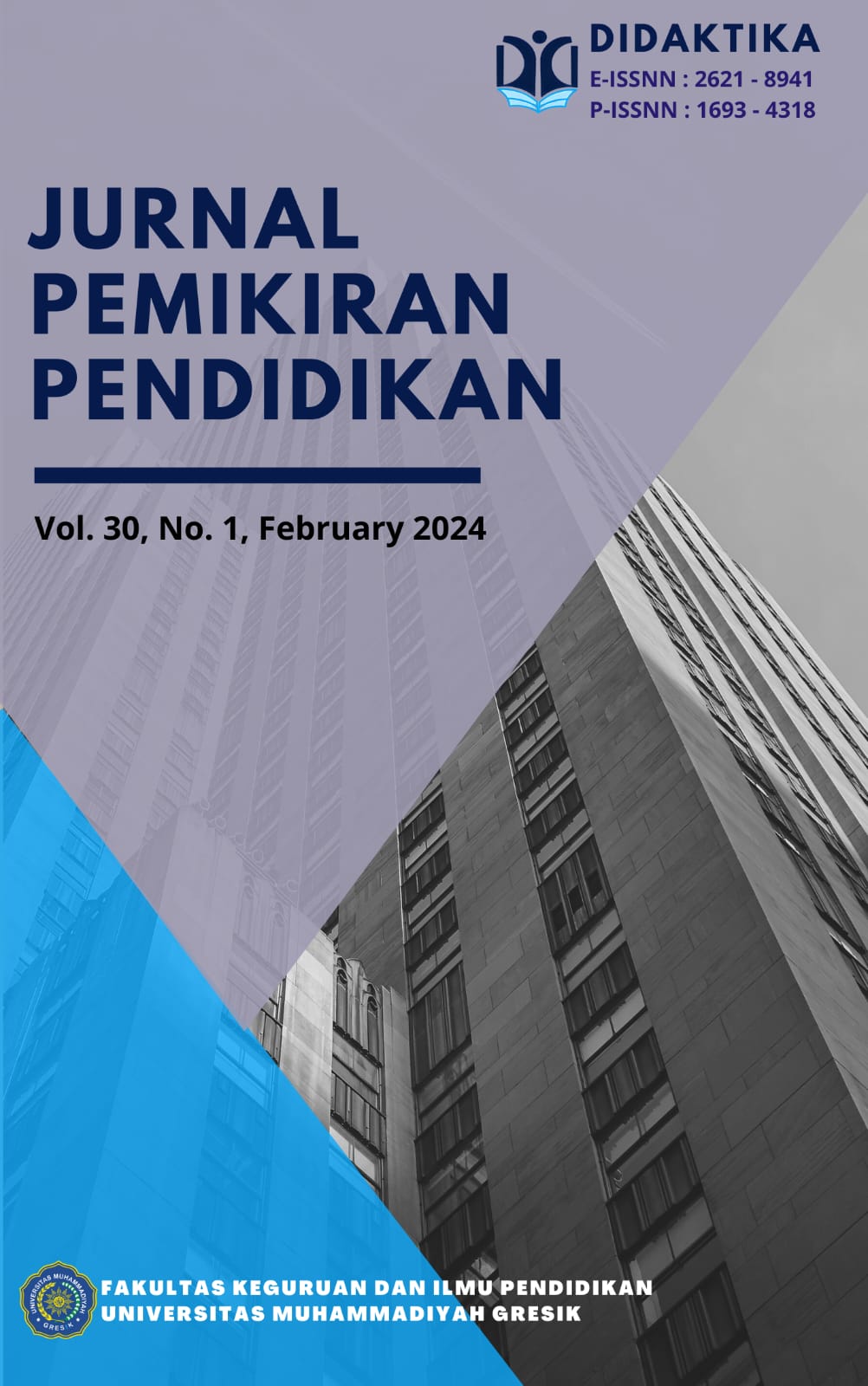Kemampuan Siswa Dalam Memecahkan Masalah Soal Cerita Fungsi Ditinjau dari Perbedaan Kemampuan Matematis
DOI:
https://doi.org/10.30587/didaktika.v30i1.7434Keywords:
Kemampuan matematika, pemecahan masalah, soal ceritaAbstract
Penelitian ini bertujuan untuk mendeskripsikan kemampuan siswa dalam memecahkan masalah soal cerita pada materi fungsi komposisi dan fungsi invers. Menurut Polya terdapat beberapa langkah dalam menyelesaikan masalah yakni yaitu memahami masalah, perencanaan pemecahan masalah, melaksanakan perencanaan pemecahan masalah, dan melihat kembali kelengkapan pemecahan masalah. Subjek dalam penelitian ini yakni 3 siswa kelas XI-6 SMAN 1 Gresik yang diambil berdasarkan perbedaan kemampuan matematis yang telah diuji menggunakan tes diagnostik awal, kemudaian diwawancara hasil kerja mereka berdasarkan langkah-langkah Polya. Pengumpulan data adalah tes diagnostik, tes tulis dan wawancara. Teknink analisis data yakni deskriptif kualitatif. Hasil dari penelitian yaitu siswa dalam kategori kemampuan matematis tinggi dapat menyelesaikan soal dengan benar dan melalui tahapan dengan tepat sesuai dengan prosedur Polya; siswa dalam kategori sedang dapat menyelesaikan soal dengan benar, tetapi masih kurang tepat dalam mengikuti tahapan sesuai dengan prosedur Polya; dan siswa dalam kategori kemampuan matematis rendah masih kurang mampu menyelesaikan soal dengan benar dan sesuai dengan prosedur pemecahan masalah polya.
References
Daulay, K. R., & Ruhaimah, I. (2019). Polya theory to improve problem-solving skills. Journal of Physics: Conference Series, 1188(1). https://doi.org/10.1088/1742-6596/1188/1/012070
Fadilah, N. S., & Hakim, D. L. (2022). Kemampuan Pemecahan Masalah Matematis Siswa SMA Pada Materi Fungsi dengan Tahapan Polya. Jurnal Theorems (The Original Reasearch Of Mathematics), 7, 64–73.
Fitriani, F., Hayati, R., Sugeng, S., Srimuliati, S., & Herman, T. (2022). Students’ Ability To Solve Mathematical Problems Through Polya Steps. Journal of Engineering Science and Technology, 17, 25–32.
Garofalo, J., Drier, H., Harper, S., Timmerman, M. a., & Shockey, T. (2000). Promoting appropriate uses of technology in mathematics teacher preparation guidelines for technology-based activity. Contemporary Issues in Technology and Teacher Education, 1(1), 66–88. http://www.editlib.org/p/10804/
Kurniawan, P., & Wijayanti, P. (2022). Profil Metakognisi Siswa Sma Dalam Memecahkan Masalah Matematika Materi Fungsi Komposisi Dan Fungsi Invers Ditinjau Dari Kemampuan Siswa. MATHEdunesa, 11(3), 644–656. https://doi.org/10.26740/mathedunesa.v11n3.p644-656
Margaret Hilton, R. (2010). Exploring the Intersection of Science Education and 21st Century Skills: A Workshop Summary. https://books.google.co.id/books?id=SZVhAgAAQBAJ&lpg=PP1&ots=ACyJFGbLMy&dq=National Research Council of The National Academies (2010)&lr&hl=id&pg=PP1#v=onepage&q=National Research Council of The National Academies (2010)&f=false
Martin, I., & Kadarisma, G. (2022). Analisis Kemampuan Pemecahan Masalah Matematis Siswa SMA Pada Materi Fungsi. Jurnal THEOREMS (The Original Research of Mathematics), 7(1), 64. https://doi.org/10.31949/th.v7i1.3824
Matthew B. Miles, A. M. H. (1994). Qualitative Data Analysis: An Expanded Sourcebook. SAGE Publications. https://books.google.co.id/books?hl=id&lr=&id=U4lU_-wJ5QEC&oi=fnd&pg=PR12&dq=miles+and+huberman&ots=kGSC0MVS-S&sig=awTdU5llfCfe6x-pvp4YTUkWFJg&redir_esc=y#v=onepage&q=miles and huberman&f=false
Nuryana, D., & Rosyana, T. (2019). Analisis Kesalahan Siswa SMK dalam Menyelesaikan Soal Pemecahan Masalah Matematik pada Materi Program Linear. Jurnal Cendekia: Jurnal Pendidikan Matematika, 3(1), 11–20.
Risma Astuti, D. (2019). Kemampuan Pemecahan Masalah dalam Menyelesaikan Soal Cerita berdasarkan Langkah Polya Semarang. Vol.2,No.2, h.299.
Scherer, R., & Gustafsson, J. E. (2015). The relations among openness, perseverance, and performance in creative problem solving: A substantive-methodological approach. Thinking Skills and Creativity, 18, 4–17. https://doi.org/10.1016/J.TSC.2015.04.004
Sugiyono. (2019). Metode Penelitian Pendidikan (kuantitatif, kualitatif, kombinasi, R&B dan penelitian pendidikan) (A. Nuryanto (ed.); ke 3). Alfabeta.
Downloads
Published
How to Cite
Issue
Section
License
License and Copyright Agreement
In submitting the manuscript to the journal, the authors certify that:
- They are authorized by their co-authors to enter into these arrangements.
- The work described has not been formally published before, except in the form of an abstract or as part of a published lecture, review, thesis, or overlay journal.
- That it is not under consideration for publication elsewhere,
- That its publication has been approved by all the author(s) and by the responsible authorities – tacitly or explicitly – of the institutes where the work has been carried out.
- They secure the right to reproduce any material that has already been published or copyrighted elsewhere.
- They agree to the following license and copyright agreement.
Copyright
Authors who publish with DIDAKTIKA: Jurnal Pemikiran Pendidikan agree to the following terms:
- Authors retain copyright and grant the journal right of first publication with the work simultaneously licensed under a Creative Commons Attribution License (CC BY-SA 4.0) that allows others to share the work with an acknowledgment of the work's authorship and initial publication in this journal.
- Authors are able to enter into separate, additional contractual arrangements for the non-exclusive distribution of the journal's published version of the work (e.g., post it to an institutional repository or publish it in a book), with an acknowledgment of its initial publication in this journal.
- Authors are permitted and encouraged to post their work online (e.g., in institutional repositories or on their website) prior to and during the submission process, as it can lead to productive exchanges, as well as earlier and greater citation of published work.
Licensing for Data Publication
Open Data and Software Publishing and Sharing
The journal strives to maximize the replicability of the research published in it. Authors are thus required to share all data, code or protocols underlying the research reported in their articles. Exceptions are permitted but have to be justified in a written public statement accompanying the article.
Datasets and software should be deposited and permanently archived inappropriate, trusted, general, or domain-specific repositories (please consult http://service.re3data.org and/or software repositories such as GitHub, GitLab, Bioinformatics.org, or equivalent). The associated persistent identifiers (e.g. DOI, or others) of the dataset(s) must be included in the data or software resources section of the article. Reference(s) to datasets and software should also be included in the reference list of the article with DOIs (where available). Where no domain-specific data repository exists, authors should deposit their datasets in a general repository such as ZENODO, Dryad, Dataverse, or others.
Small data may also be published as data files or packages supplementary to a research article, however, the authors should prefer in all cases a deposition in data repositories.











